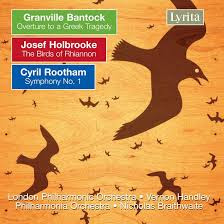This is a rewarding selection of Francis Poulenc’s piano music. The recital begins with the Valse FP17 which was his contribution to the L’Album des Six published in 1919. As will be guessed the other composers were Milhaud, Honegger, Durey, Auric, and Tailleferre. The Valse is exuberant, intriguing, and sheer fun. It nods to the ubiquitous Parisian Boulevardier as well as giving hints of Petruska.
The Suite: Napoli was
inspired during a trip to Italy during 1922. He was accompanied by his
colleague Darius Milhaud. The opening Barcarolle suggests a boat moored
in the Bay of Naples. The usual tranquillity is mocked by edgy harmonies and
changes of time signature. The Nocturne also gives the impression of the
sea, this time with moonlight. It has a magical effect. The final movement, Caprice
italien, is more about gin joints and night clubs, than land or seascapes.
Inspired by Chabrier’s Bourrée fantastique, it is a fast, sassy
tarantella, concluding with a long cadenza. Chiara Cipelli invests the entire
suite with Neapolitan magic and swagger.
The Huit Nocturnes FP56
were composed between 1929 and 1938. This prolonged period of gestation may
have led to unevenness in effect. Mostly short, these pieces contain lovely
melodies and some delicious pianism. Those that impressed me most were the
romantic Bal de jeunes fils which recalls a Parisian ballroom and the Bal
fantôme which is a ghostly waltz. The seventh Nocturne, Assez allant
(With enough motion) is poised, and played here at a pleasing speed. The entire
group is a satisfying exploration of moods, tempos, and keys. I feel that they
ought to be played as a group and not excerpted.
Despite being created for younger
pianists there is nothing childlike about the six numbers of Villageoises,
FP65 (1933). Each movement captures a different mood or scene. They display
Poulenc’s ability to capture miscellaneous emotions in a concise and
concentrated form. The Suite opens with a vivacious Valse Tyrolienne, followed
by a brisk Staccato, and an idyllic Rustique. The next three
movements feature a tumultuous Polka, a graceful Petite ronde and
a short Coda. The Suite was dedicated to the playwright Jean Giraudoux
and the actor Louis Jouvet.
Poulenc’s Trois Novelettes
were devised over a prolonged period. The first, in C major was composed in
1927. Written in ternary form, the two sections balance mischief with grace.
The second Novelette in B flat minor is really a little scherzo which is
witty and rhythmically energetic. The third was finished in 1959. It is
based on a melody taken from Manuel de Falla’s El amor brujo. It is
thoughtful and a touch melancholic.
The best-known piano work by
Poulenc is his Trois Mouvements perpétuels, FP 14a. They were finished
in 1918 and were premiered that year in Paris by the Spanish pianist Ricardo
Viñes. They were dedicated to the French artist and author Valentine Gross.
Poulenc once stated that they represented “a brisk stroll by the Seine.” Certainly,
these numbers succeed in conjuring a vivacious Parisian mood. The finale, Alerte,
is by far the most dynamic with lots of changes of rhythms and sly nods to Erik
Satie. If anything, these Mouvements nod towards Stravinsky. They are
played here with no condescension and with considerable spontaneity that
balances the influence of the eighteenth century clavecinists with the harmonic
spice of the post-World War One era.
The recital concludes with the
short, but fascinating Valse-improvisation sur le nom de Bach, FP62.
This is characterised by many modulations and an adventurous key structure. It
was completed in 1932. Strangely, at the time of writing, it was regarded as
“critically unsuccessful.” Bach is reflected in the use of his initials, B-flat,
A, C, B-natural to create the theme. It was included in an album Hommage à
Bach with contributions by Alfredo Casella, Albert Roussel, Gian Francesco
Malipiero and Arthur Honegger.
The liner notes give a decent
overview of Poulenc and his piano music, but present little information about
each piece. They are printed in English and Italian. There is a short resume of
the soloist. Her discography includes a disc of Bruno Bettinelli’s piano works
and another of Olivier Messiaen’s Préludes.
The performances reflect
Poulenc’s earlier devotion to the “precise, economical, lean and at times
witty” style that was a characteristic of ‘Les Six.’ Chiara Cipelli responds
vividly to the lyricism, wit, and occasional melancholy of these diverse pieces.
Track Listing:
Francis Poulenc (1899-1963)Valse for l’Album des Six FP17 (1919)
Napoli, Suite pour piano, FP40 (1922-25)
Huit Nocturnes, FP56 (1929-38)
Villageoises, petites pièces enfantines FP 65 (1933)
Trois Novelettes FP47 (1, 2) FP173 (3) (1927-1928, rev.1939, (1,2) 1959 (3))
Trois Mouvements perpétuels, FP14a (1918, rev.1962)
Valse-improvisation sur le nom de Bach, FP62 (1932)
Chiara Cipelli (piano)
rec. 4-5 April 2023, Classical Recording Studio, Perugia, Italy
Piano Classics PCL10217 [53]
With thanks to MusicWeb International where this review was first published.










